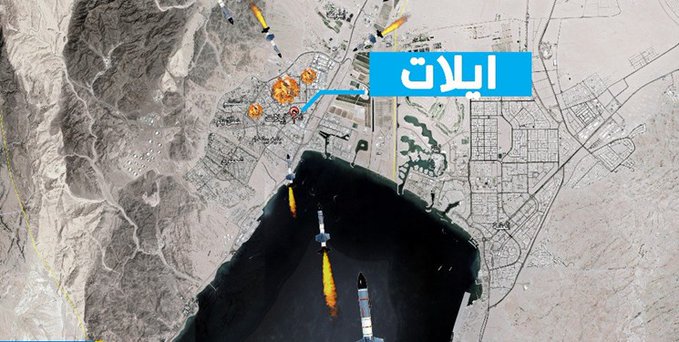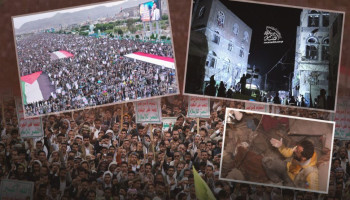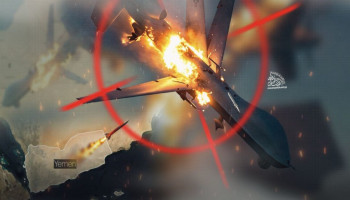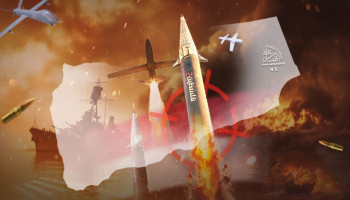The Yemeni armed forces have escalated their operations against the tripartite aggression comprising the United States, Britain, and Israel. This escalation comes in parallel with the confirmation of the leader of the revolution, Sayyid Abdul Malik Badr Al-Din Al-Houthi, on the direction towards escalating the Yemeni position supporting Gaza at all levels, including the military level.
The leader announced the entry of new qualitative weapons into battle, the most prominent of which are submarines and drones, which the enemy admitted during the past days to his concern about their effectiveness. In addition to the development of missile weapons to overcome American defenses, in credibility for previous confirmations from the leader that the attack on Yemen will not affect its capabilities but will contribute to improving them.
The spokesman for the armed forces, Brigadier General Yahya Saree, announced on Thursday evening the implementation of three qualitative military operations, within the framework of victory for the oppressed Palestinian people and in response to the American-British aggression on Yemen.
The first operation launched a number of ballistic missiles and drones at various targets of the Zionist enemy in the Umm Al-Rashrash region in southern occupied Palestine.
The second operation in the Gulf of Aden, where the naval forces carried out an operation targeting a British ship (Islander) in the Gulf of Aden, using a number of suitable marine missiles, which hit it directly, leading to the outbreak of fire in it.
In the third operation, Brigadier General Saree announced that an American destroyer in the Red Sea was targeted with a number of drones.
The Hebrew media admitted the first operation, where the newspaper “Yediot Aharonot” quoted one of the settlers in occupied Umm Al-Rashrash (Eilat) as saying that he woke up to the sound of warning sirens in the morning and rushed to the shelter, indicating that he heard the sound of explosions and ambulances.
The newspaper said that the alarms were activated in several areas during the attack, and quoted another settler as saying that since the Yemeni strikes entered the scene, “we realize that we are threatened, and we got used to going down to the shelters” according to him; which clearly indicates that the Yemeni strikes have turned the area that the enemy has prepared as a safe haven for its settlers into a danger zone.
The American-British enemy also admitted the second operation, where the British Maritime Trade Operations Authority said that the fire broke out in the “Islander” ship after it was hit by two missiles, and the “Amber” maritime security company confirmed that the ship, which raises the flag of Palau, is owned by a British party, and later the American Central Command admitted that the ship was damaged.
The American enemy tried to cover up the third operation that targeted one of its destroyers, but the Pentagon later referred to an “increase” in Yemeni operations, in an attempt to hide the details that could constitute a resounding slap for the American navy, where the Yemeni missiles had previously succeeded in overcoming the layers of missile defense of the destroyer “USS Gravely” according to American officials and analysts who said that the destroyer had to use the last layer of defense it had, and that it clashed with a Yemeni missile that was only about two seconds away from hitting it; which means that the armed forces have actually succeeded in overcoming the very costly American defenses.
This is also what the leader of the revolution confirmed, who revealed in his last speech on Thursday that the Yemeni missiles have been developed and have become overcoming the defenses of the enemy, and also revealed the start of using unmanned submarines, which American officials and officers had expressed during the past days their concern about their effectiveness, and a former official in the Pentagon told the “New York Times” newspaper: that “monitoring and tracking these submarines and boats is more difficult than monitoring drones and missiles”, indicating that “using different types of naval weapons in one attack will overcome the defenses of any ship”.
The American admissions of the development of Yemeni capabilities, which come in light of realistic data, prove the confirmations of the leader of the revolution in several previous times that targeting Yemen will not affect its military capabilities but will contribute to their development and improvement. It is clear that the armed forces, within their distinguished activity, are conducting a professional study of the enemy’s advanced capabilities on the field of live confrontation, which provides information and readings that are difficult to obtain in experimental laboratories and simulation tests.
The leader of the revolution confirmed in his last speech clearly that Yemen is heading towards escalating operations “quantitatively and qualitatively” in response to the Zionist escalation in Gaza, and the ongoing aggression on Yemen. This was clearly translated by the last tripartite qualitative operation, which came just two days after a large attack by the Yemeni drone air force on American ships in the Red Sea and the Arabian Sea, sensitive sites of the Israeli enemy in Umm Al-Rashrash, in addition to the Israeli ship “MSC Silver” in the Gulf of Aden.
The features revealed by these two operations on the Yemeni escalation path confirm to the enemy, without leaving room for doubt, that the repercussions of the continued aggression on Gaza (and what it includes of ongoing aggression on Yemen) will exceed their expectations, which have proven to be inaccurate both in the field and politically. The return to targeting the Zionists in the occupied Palestinian territories, and the implementation of simultaneous strikes on American and British targets, including military “destroyers”, is not just an “intensification” of operations. Rather, it is an indicator that the quality of strikes is on its way to becoming more destructive and having a wider impact. The operation of sinking the British ship “Rubymar” last week clearly demonstrated this, as did the leader of the revolution by clarifying that the escalation will be both “quantitative and qualitative”.
Even the quantitative aspect of this escalation poses a major challenge to the enemy, considering the high costs it incurs in its failed attempts to confront the Yemeni operations. The American “CBS” network revealed last week that American warships have so far used 100 standard missiles (of the SM-6 type) the value of one of which exceeds 4 million dollars, not to mention the cost of the aggressive operations on Yemen, and the costs of operating the Eisenhower aircraft carrier that has not docked at a port for months, which are heavy costs that will undoubtedly double when the armed forces intensify their operations in terms of number. As for the severity of the strikes and their quality, the matter is open to possibilities that are more terrifying to the enemy who now knows that his destroyers at sea, for example, are not as fortified as he thought.







